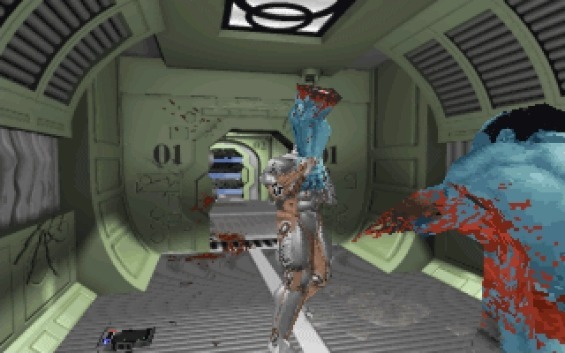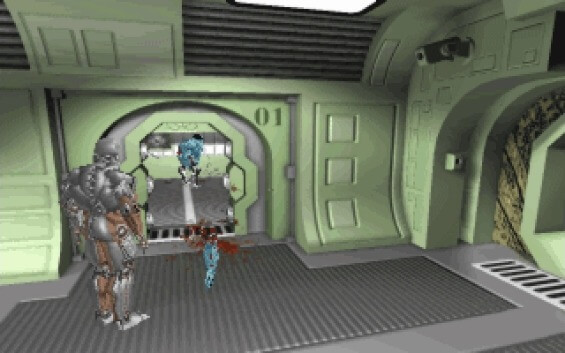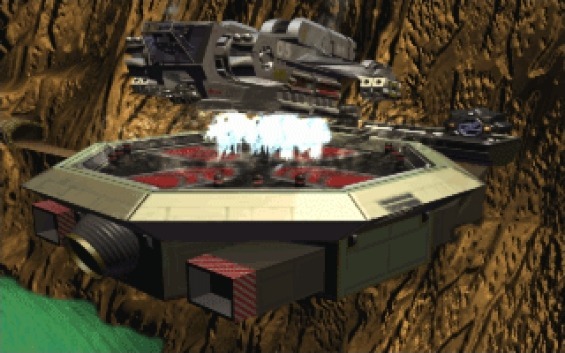BioForge is an adventure game developed by Origin Systems and published by Electronic Arts for Microsoft Windows and MS-DOS. The game was marketed as a movie-like production, because of its in-depth plot and extensive voice acting (with 22 different voice actors for characters and computer voices). The game was localized in four languages: English, German, French and Spanish (screen text and subtitles only).
The game was very hardware-demanding in 1995, requiring 8 MB of RAM and a 486 CPU running at 33 MHz at least, due to its use of texture-mapped, detailed 3D models and a software renderer.
BioForge had generally favorable reviews.
Story
In the far future, the known universe is ruled by an organization known as 'the Reticulum'. There is also an opposite fanatical group of religious extremists known as the Mondites, who believe in the evolution of man through machine by cybernetic implants, and aspire to galactic conquest under the direction of their insane leader, the Prime Paragon.
Years ago, a Reticulum ship called Ambassadoria made contact with an ancient spaceship containing alien remains in stasis. One alien was transferred to the ship for examination. However it returned to life and destroyed everything until the ship self-destructs, after her captain recorded a log. The Mondites however received the distress call before the Reticulum could be notified; through studying the black box and the remains, they finally discover the aliens' homeworld, a moon which they name Daedalus (named after the Greek myth) in a remote sector of the galaxy and establish a base while investigating the ruins the aliens left behind; a sentient race known as the Phyxx who were long thought to be extinct.
To their end, the Mondites abduct people and subject them on Daedalus for their experiments. A mad scientist called Dr. Mastaba who is the base commander and head of the "ABA Project" (Assassin Biologically Augmented) conducts these experiments under the guise of scientific research, mutilating the bodies of his victims in an attempt to turn them into the ultimate killing machine. However, everyone so far has ended up either dead or insane.
Using technology borrowed from the Phyxx, the Mondites have finally succeeded in their experiments. But when one of the aliens is accidentally revived from suspended animation in its tomb, it goes on a rampage through the complex, damaging the reactor and killing half of the base personnel in the process.
The player takes on the role of a cyborg whose original identity is based on how the player responds to various events in the game. (Experimental Unit AP-127) who awakens in a cell on Daedalus with no prior memories. After escaping the cell, the player seems to be one of the scant survivors of the incident that has devastated the station. He must unravel the truth about himself, the research station, the bizarre Mondite cult that controls it, and the mysterious ancient alien race that once inhabited the moon.
The game ends rather abruptly after the player escapes Daedalus in an experimental spacecraft in the wake of the moon's destruction, escorted by several Phyxx Blockships.
A sequel (BioForge II) was designed and the team were working on the art when the project was halted and changed to an expansion of the original game. The expansion, however, was also cancelled and subsequently never published.
Gameplay
BioForge centers mainly on exploration and puzzle solving using items, and also on fighting and interaction with NPCs. The ultimate goal of the game is not obvious at the beginning, since the player is unaware of his identity, which depends on his actions during the game. The player has full control over the main character's actions. This was a deliberate idea of Ken Demarest and Jack Herman. Richard Garriott helped kick off the Interactive Movie theme. In a 1994 magazine article he said that "Interactive Movies have become a buzzword, so it's being applied to games which really aren't. Just because a game has FMV that doesn't automatically make it an interactive movie, because you have very little control over the actor. Neither is a game in which you click on an icon, then sit back and watch a scene take place."
The player character can rotate left and right, walk and run forwards and backwards, and sidestep. The player can also enter a combat stance that makes several punch and kick movements and hand-to-hand weapons (if carried) available. Combat is awkward and has a steep learning curve since enemies must be faced at precisely the correct rotation angle for attacks to connect. Also, since camera angles are fixed, the view can change in an unpredictable manner if the player crosses scene-thresholds during the fight, a gameplay problem first seen in Alone in the Dark and which persisted into later games using fixed camera angles such as Resident Evil.
The body of the player character houses an exchangeable (and depletable) battery that powers various body functions put there by the experimenters. Functions include a regeneration system that heals all damage when activated, as well as a powerful projectile weapon (known as the PFD Prototype). Upgrading and swapping the battery is key to the player's progress at certain points in the game. The player can also don a protective armoured suit that enables him to survive the harsh atmosphere outside the facility and explore the archaeological dig.
Various objects, such as datalogs or healing packs, can be picked up and stored in the player's inventory. Selected objects are shown carried in the left hand of the player character. Several hand-to-hand and ranged weapons, as well as batteries and other large or one-use objects, can also be picked up during the course of the game, but only one can be carried, using the right hand, and they cannot be stored in the inventory.

















